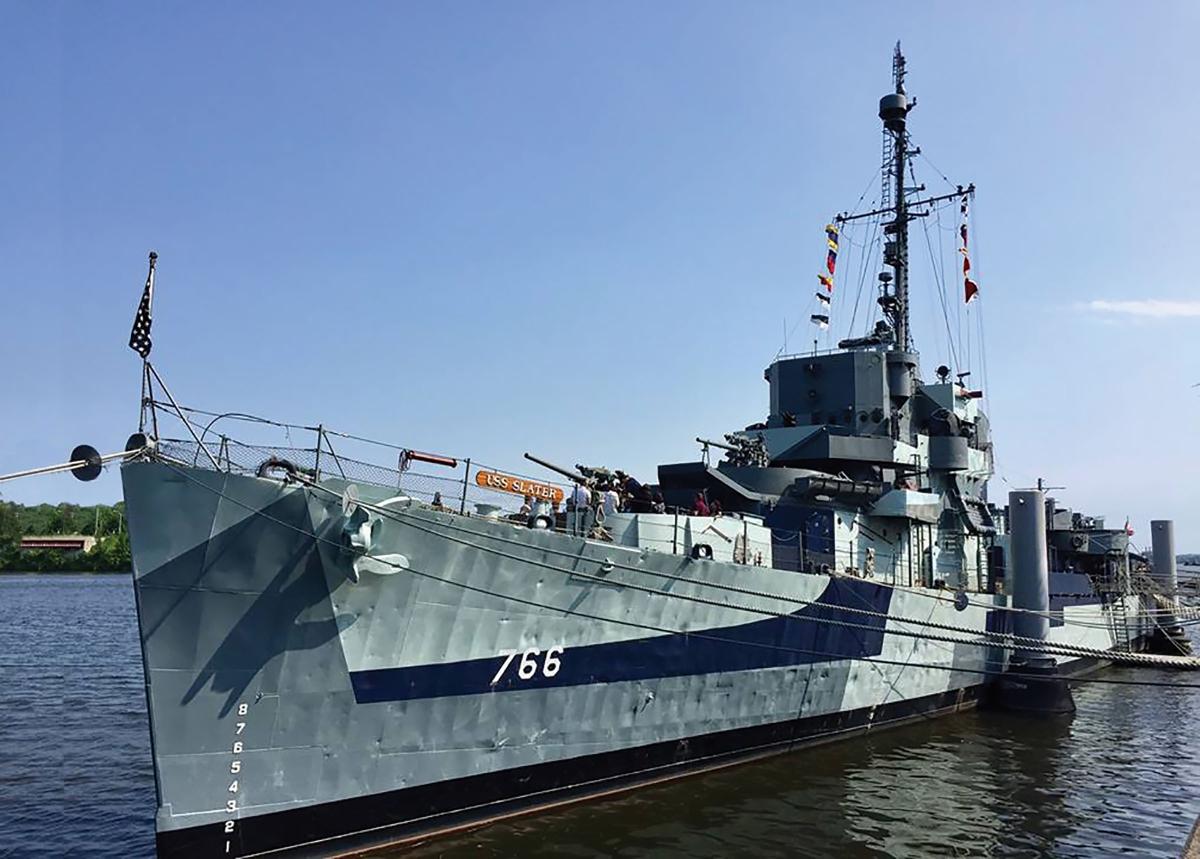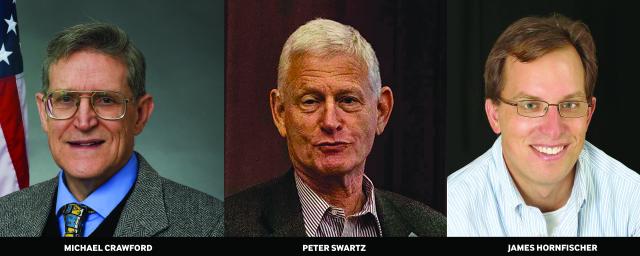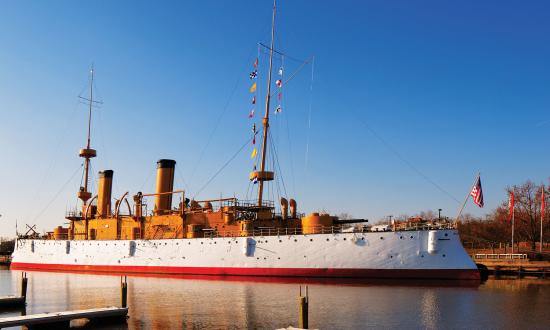WWII Destroyer Escort Heads Down the Hudson
On Sunday, 5 July, onlookers gathered on boat decks and along the shoreline to cap off the Fourth of July weekend with a view of the last destroyer escort afloat in the United States—the USS Slater (DE-766)—departing her anchorage at Albany, New York, making her way down the Hudson River by tug escort to Staten Island for shipyard repairs.
The ship, now a floating museum, made a similar downriver voyage in 2015. For the current repair cycle, the work focused on the mast, but workers also inspected the hull below the waterline and gave her a fresh paint job while she was drydocked. The Albany Times Union reported that the work is estimated to cost $700,000— of which $200,000 will be covered by a National Park Service Maritime Heritage Grant. The Destroyer Escort Historical Museum, the nonprofit that owns and operates the Slater, “is looking to raise $500,000 to fully fund the restoration work,” according to the Times Union.
Launched and commissioned in 1944, the Cannon-class destroyer escort was named in honor of Seaman Second Class Frank O. Slater, who died manning his gun on board the USS San Francisco (CA-38) off Guadalcanal in November 1942. He was posthumously awarded the Navy Cross.
After convoy escort duties in World War II, the Slater became part of the Hellenic Navy, under the auspices of the Truman Doctrine, in 1951. She and three Cannon-class sister ships likewise transferred to Greek service became dubbed “the Wild Beasts Flotilla.” Renamed the Aetos, she patrolled the Aegean and served as a training vessel, and was decommissioned in 1991. She arrived at her museum-ship home port of Albany in 1997.
As an interesting side note, the Slater/Aetos had a role in the 1961 World War II adventure-movie classic The Guns of Navarone.
At press time, the Destroyer Escort Historical Museum was planning to have the Slater back on the Albany waterfront and open to the public (Wednesdays through Sundays through November) by early August. For updates and more information, go to www.ussslater.org.
Naval Artifact Rescued from Reno Riot
On 30 May, as a protest triggered by the death of George Floyd devolved into violence in Reno, Nevada, rioters caused an estimated $100,000 in damages, eventually breaking into City Hall and trashing the premises. And amid the chaos, a U.S. Navy relic disappeared.
The ensign of the USS Reno (CL-96) had been on longtime loan—along with ship’s bell and commissioning pennant—to its namesake city’s seat of government from the collection of the Naval History and Heritage Command (NHHC). As the dust settled from the destruction in Reno City Hall, the 48-star flag that flew in World War II was gone.
Three days later, KRNC News 4 content manager Kenzie Margiott received a mysterious package at the NBC affiliate’s newsroom. Intrigued, thinking it might be a birthday present, she opened it.
It was indeed a present—to the preservation of naval history. The package contained the rescued Reno ensign, along with an anonymous note in Sharpie scrawl: “Needed protecting. Looters were flag burning. R.I.P. George Floyd.”
The artifact is out of harm’s way now, having been returned to the NHHC for safekeeping. Despite this particular close call in a time of social strife, NHHC Curator Branch Head Jeffrey Bowdoin underscored the importance of the NHHC’s artifact-lending program.
“Artifact loans are important because they provide a tangible connection to the past,” he said.
“Specifically for the citizens of Reno, there is a personal connection to these artifacts from the USS Reno. Historically, the citizens from the cities and states of the namesake ships hold tremendous pride in these ships and their crews, with many community members forming long-lasting ties between the ship and community.”
The Reno, an Atlanta-class light cruiser, played an active role during World War II, supporting air strikes and assisting in the repulse of a
large-scale Japanese carrier force attempt to defeat the Allied invasion of Saipan in the Battle of the Philippine Sea in 1944.
As part of Task Force 58, the Reno also is known for coming nearer to the Home Islands of Japan than had any other major unit of the U.S. fleet by October 1944, shooting down six enemy planes during a three-day strike against Formosa. The Reno was decommissioned in 1946 after having earned three battle stars.
The loan of an artifact from the NHHC to the city or state namesake of a ship is common. Bowdoin noted that quite a few Navy battleship artifacts have been loaned to their namesake states as well as to areas of historical significance for a particular ship.
“We use these artifacts as a means to educate people about the Navy’s history, customs, and culture and provide that connection to the past in a manner that only a physical object can,” said Bowdoin. “Many maritime museums in the United States have artifacts on loan from Curator Branch, as well as a huge variety of veterans’ groups, state and local municipalities, historical societies, history museums, and Navy commands ashore and afloat.”
2020 Knox Award Winners Announced
The annual meeting of the Naval Historical Foundation (NHF) on 11 June featured the announcement of this year’s recipients of the prestigious Commodore Dudley W. Knox Medal for contributions to naval history: Michael J. Crawford and retired Navy Captain Peter Swartz.
Crawford, who earned his PhD from Boston University in 1978 and briefly taught at Texas Tech, joined the staff of the Naval Historical Center in 1982 as the assistant head of the Research (Early History) Branch. He made significant contributions to the multivolume Documents of the American Revolution series (recently digitized by the NHF) and the four-part The Naval War of 1812: A Documentary History. Crawford’s efforts have made thousands of documents accessible to researchers.
From 2008 until his retirement from the NHHC in 2017, he held the distinguished title of Senior Historian of the Navy.
Whereas Crawford earned his recognition for his 18th- and 19th-century work, Swartz is an expert on 20th- and 21st-century Navy strategy, policy, and operations. His recent work examines Navy strategy, the organizational history of the Navy and the Office of the Chief of Naval Operations, U.S. Navy international relationships, and U.S. interservice relationships, policies, and doctrine.
Swartz played a leading role in conceptualizing and drafting the Navy’s maritime strategy of the 1980s, serving on the staff of successive Chiefs of Naval Operations and of Secretary of the Navy John Lehman. He was director of defense operations for the U.S. mission to NATO as the Berlin Wall was coming down and served as special assistant to Chairman of the Joint Chiefs of Staff General Colin Powell during the first Gulf War.
The NHF’s annual meeting also included the announcement that the prize-winning chronicler of the naval war in the Pacific, James D. Hornfischer, would be the recipient of the NHF’s 2020 Distinguished Service Award, which recognizes an individual who has worked to promote naval history and heritage within the Navy and beyond to the American public.
Hornfischer’s books have led reviewers to rate him as one of the most commanding naval historians writing today. His most recent book, The Fleet at Flood Tide: America at Total War in the Pacific, 1944–1945, received the Navy League’s 2017 Commodore John Barry Book Award.
Neptune’s Inferno: The U.S. Navy at Guadalcanal (2011), a New York Times bestseller, was chosen as a best book of the year by numerous book reviews. The Last Stand of the Tin Can Sailors (2004), a combat narrative about the Battle off Samar, received the Samuel Eliot Morison Award from the Naval Order of the United States.








